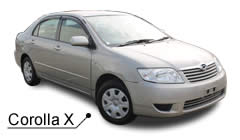How The NZE121 Became One Of The Best Selling Chassis In The World - Vol.179
The Toyota Motor Company was founded in 1937 as a spin-off company from the larger Toyota Industries by Kiichiro Toyoda. Kiichiro's father, Sakichi Toyoda, was the owner of Toyota Industries, but Kiichiro used the parent company's assets and resources to branch out into automobile manufacturing. While still a mere department of the larger Toyota Industries, TMC created its first engine in 1934, following that with its first passenger car, produced in 1936. From these humble beginnings, the Toyota Motor Company has risen to be one of the most well-known, well-revered and powerful companies in the entire world. Despite having manufactured its first automobile while still associated with Toyota Industries, in the summer of 2012 Toyota produced its two hundred millionth automobile.

Tops among the vast fleet of cars that the Toyota Motor Company has released is its Corolla line of automobiles. The Corolla, whose name means "crown," is head and shoulders above the rest of Toyota's line of vehicles. Only the Land Cruiser is an older product. In 2013, it was estimated that Toyota had sold approximately forty million cars that had been designed and built around the Corolla specifics, which accounts for just under twenty percent of the total sales of all Toyota automobiles. This is even more impressive when taken into account that the first Corolla was produced in 1966, thirty years after the first passenger car was produced.
Originally, the Corolla was a rear-wheel-drive compact to subcompact car. The size, performance, and handling of the car soon helped it become one of the top sellers in Japan. The Toyota Motor Company then began releasing the Corolla in foreign markets, hoping that all of the things that made the car popular in the domestic market would boost the popularity of the car overseas. The roll of the dice paid off, and by 1974, the Corolla became one of the best-selling vehicles on the road worldwide. Coupled with this success, a "rebadged" version of the Corolla known as the Sprinter was being sold in the Japanese domestic market, helping to strengthen the significance of the Corolla platform for the Toyota Motor Company.
Rebadging, sometimes referred to as "badge engineering," is the practice of taking an existing car and putting a different name on the car. Sometimes, the rebadging is done when automobiles are introduced into new markets worldwide, or in the case of the Sprinter, when a car is released in one specific market. Thanks to this practice, the Corolla nameplate became the top-selling name in the world in 1997, bypassing the Volkswagen Beetle for the top spot.
Rather than pour thousands of dollars into redesigning new cars from the ground up, many automobile manufacturers will partake in what is known as platform sharing, where the technology for one car is spread out across a variety of other offerings from the same company. In the case of Toyota, the NZE121 chassis has become one of the most reliable and often used chassis across their line of products. It has been used not only for the Corolla and the Sprinter, but it has been utilized in the Allex and RunX hatchback models, the Fielder and Spacio station wagons, as well as the Corolla Altis.
This is not to say that the Corolla has not gone through several redesigns. As new technologies have become available, they have been incorporated into the design of the Corolla, all the way from the chassis up to the physical appearance of the automobile. Currently, the Corolla is on its eleventh generation; in a way, it is an automotive version of the British sci-fi hero Dr. Who. Without a doubt, the Corolla platform has been as successful a car model as there has ever been or perhaps ever will be. The popularity of the Corolla has now spread over to hybrid vehicles, as well, with the release of hybrid versions of the Axio and the Fielder, though these cars now utilize a different chassis than the NZE121.